How to Store Wool Sweaters

When you look at your wardrobe, congested with seasonal clothing and cozy wool sweaters, you might wonder, “Does anyone else struggle with storing wool sweaters like me?” Even if your closet is massive, you want to remove all reminders of the colder months from sight and free up space for your summertime garments. So then, what do you do with the bulk? Easy, we’re going to explain how to store sweaters for the summer to make things more manageable.
Woollen garments can be heavy or loosely woven. Because of that, there’s no one-size-fits-all solution to storing your woollens. However, we’ve got some basic guidelines to make packing up your wool sweaters less of a gauntlet. We’ve also got some advice on how, once stored, to keep them smelling fresh and protected from moths.
And guess what? These tips are REALLY easy to follow, too!
What to do Before Storing Wool Sweaters
Use this time to do a bit of decluttering of your wardrobe to make space for any new additions as well as removing any woollens you no longer want. You can toss them to the side to either donate or recycle at a later date. To help you decide: consider whether the piece of clothing still fits correctly, if it is damaged or permanently stained, or if you haven’t worn the sweater for the past few years.
Anything you haven’t worn can be donated. Go ahead and dispose of or creatively recycle any damaged clothing.
Now, with that out of the way, there are a couple of other steps to take with the wool sweaters that you definitely want to store. First, start off on the right foot. Take your pullovers to be dry-cleaned, if necessary, or hand-wash them at home. Even if the wool looks clean, you don’t want any odours or bacteria remaining trapped in the fibres for several months. Don’t forget to properly dry your wool sweaters before putting them into storage. Otherwise, they will smell musty when you go to wear them again.
Pick a dry, cool location to store your sweaters. A closet is best. We wouldn’t recommend storing your winter wear in the basement as the chance of excess moisture is high. Pack your pullovers in an airtight or vacuum-sealed container with silica packets or other moisture absorbents.
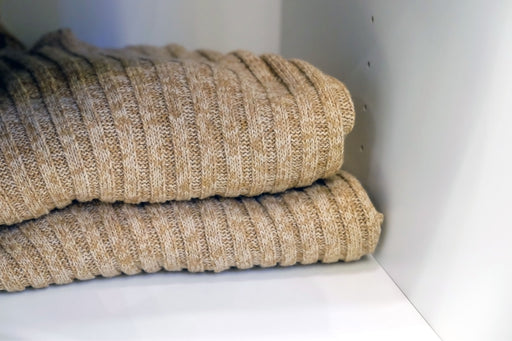
Keep in mind that storing wool is different from how to store cashmere sweaters. You also never want to put the two materials together in the same storage bin or bag, because the materials could compromise one another.
Much like you and I - Wool needs to breathe!
The Best Way to Store Wool Sweaters
Once you have your wool sweaters laundered and a spot chosen for storage, it is time to choose how you plan to keep the material safe. When not in use, your wool garments are more vulnerable to mould, dust, clothes moths, and general wear and tear. Luckily, there are plenty of ways for you to protect your woollens and keep them in peak condition for next year.
Vacuum-Packed Bags
Although many people use vacuum-packed bags for travelling light, you can utilise these nifty bags to store pullovers, too. Not only are your clothes protected from moths and dust, but you get the additional benefit of more space. That will make things much, much easier when it comes time to arrange the bags in the storage space.
But what about the disadvantages? Vacuum-sealed bags are not foolproof. Overtime, the seal will weaken, sometimes introducing air and moisture into the bags. Reseal them once in a while to prevent that from happening.
Cloth Storage Bags
Not to be confused with garment bags, these storage bags are often rectangular in shape, zippered, and made with a breathable fabric. Though they are less convenient than vacuum-packed bags in terms of saving space, they do allow for your wool sweaters to breathe. If you are worried about woven garments snagging on the zippers, you can wrap them in tissue paper, which will also prevent yellowing.
Boxes and Bins
An easy to find option are storage containers. The downside to any of them is that, in order to store anything in these bins and boxes, you need enough space for them. To store sweaters, you can use collapsible cotton bins. The advantage here is that the cotton allows the wool sweaters to breathe while keeping dust and pests out. Put the heaviest knits on the bottom.
Plastic bins that go under the bed or on the upper shelves of your wardrobe are acceptable, too. You will have to take an extra step to counter any potential humidity getting trapped inside. Place some silica packets in any plastic storage bins before piling up your sweaters.
How to Fold Wool Sweaters
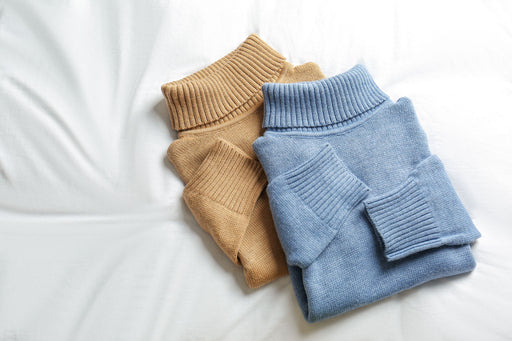
The best way to store wool sweaters is to fold them. Then you can decide how you want to store them—bin, box, vacuum bag—and where. Folding them helps keep their shape and also prevents wrinkles.
Fold sweaters like a pro by following these steps:
- Lay your sweater out so that the front faces you.
- Fold a sleeve inwards at a diagonal, so that the cuff is opposite from the shoulder. Do the same with the other sleeve.
- Smooth it out with your hand to remove wrinkles.
- Take the hem of the garment and bring it towards the neck. If the garment is thick or has a chunky knit, roll it instead of folding it.
- If you had to roll it, use two loose elastic bands to keep the roll secure. Bring both ends of the roll together, forming a circle. Use another rubber band to keep it in place.
Other Tips on How to Store Wool Sweaters
If you’re thinking about storing your winter wear for the glorious spring and summer seasons, there may be some considerations that haven't even crossed your mind.
Never fear! We’ve got you covered.
Don’t Hang Your Wool Sweaters—Unless You Do This
Usually, we are adamant about not folding pullovers made from heavier natural fibres like wool, angora, and cashmere. The weight of the fabric will cause them to stretch and lose shape, which is the last thing you want. Even a sweater made out of cotton can stretch when it’s hung incorrectly.
So, we’ll say it again: Never hang your pullovers unless you know how to do it correctly. Here is the best way:
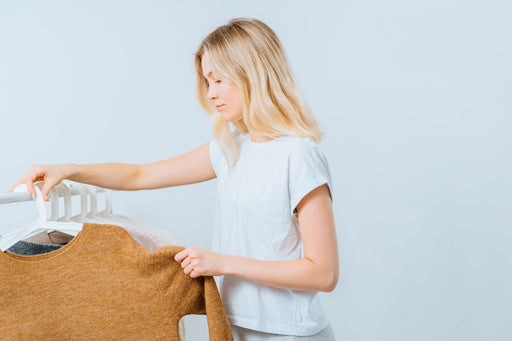
- Lay the sweater onto a flat surface and fold it vertically in half. Both arms will point in the same direction.
- Fold it from the centre.
- Once you have it folded neatly, remove the wrinkles by running a hand over the fabric.
- Now, you can choose two ways: either hanging the sweater like you would a pair of pants on the bottom part of the hanger or by using the arms as an anchor. If you choose the latter, keep reading.
- Set the hanger (always wooden or padded, never wire) over the folded garment so that the hook is near the armpit.
- Once you have the hanger into position, move the hook into the space between the sleeves and the torso, so it’s pointed either up or down.
- Put the sleeves over the shoulders of the hanger. Try to keep them folded. The sleeves should be as close to the hook as possible.
- If you have a bottom bar, put the sleeves over the shoulder then down over the bottom bar, tucking them into place.
- Next, put the body of the sweater into place over the other shoulder. The shape should be triangular when done correctly.
- Hang in a place where it won’t get crinkled.
Keep Pests At Bay
Regardless of which method you choose for storing your wool garments, you need to be aware of the risk of moths and other insects making a home amid your off-season clothing. That is one surprise you don’t want to experience when you go to unbox your cosy garments. Most people immediately reach for mothballs to protect their clothing, since the item works to repel moths and absorb moisture.
You can also use more natural alternatives, such as cedar chips or blocks or lavender-scented
sachets. Lavender soap, mint leaves, and neem oil will also do the trick. Not only will moths stay far away, but the scent is much more pleasant.
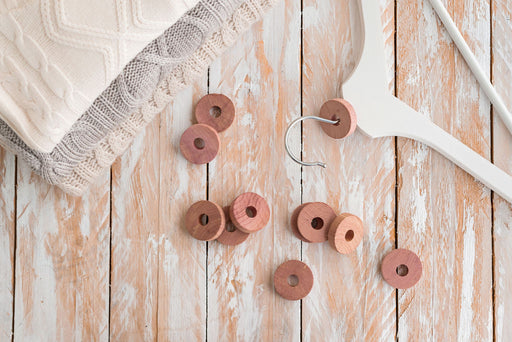
Keep in mind that any clothing that vaguely smells of human odour, whether from sweat or oils, can attract clothes moths. That is why it is so important to wash your woollens prior to sealing them away with cedar or lavender.
Double Check The Space
So, you have your wool sweaters folded up and ready to be stored away. There is one last step before you can wipe the dust from your hands and start organising your summer closet. Always double check the space where your pullovers will be stored. Wipe down the shelves or floor with some standard cleaning solution, let it air dry, and then place some cedar or another moth-repellent in there.
After storing your pullovers, periodically check on the storage containers to make sure there is no moisture or pests.
Bottom Line
Learning how to store your winter wear is crucial to keeping those winter warming garments looking in better condition for much longer, season after season. Be sure to fold your pullovers and place them somewhere safe for the winter. Follow the tips we listed here, and you should have no nasty surprises next season!
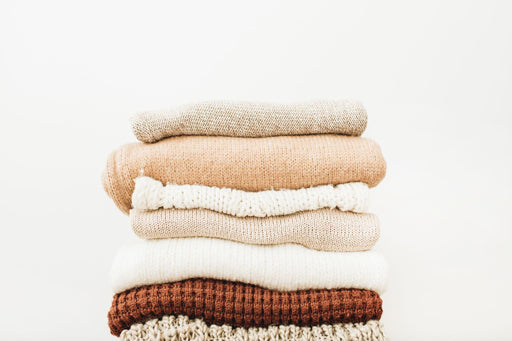
FAQs for How to Store Wool Sweaters
Wool is a wonderfully warm and water-repellent fabric. However, wool is particularly susceptible to damage in storage, especially from Clothes Moths as wool contains keratin, a primary food source for moth larvae. Here are some FAQs on wool sweater storage that you may find helpful.
How do I stop moths eating wool?
Taking a few steps to care for your garments properly before storage can make a world of difference. After all, it can be quite disheartening to pull out your favorite wool sweater on a chilly day, only to find that moth larvae have tunneled through it.
Clean All Sweaters Before Storage
Before storing your wool garments, you need to be sure that they are completely clean. Bacteria, dead skin, sweat and food debris are likely to attract moths. Since wool is prone to shrinking, it often will require dry-cleaning. You will want to take this extra precaution to prevent moths from causing problems.
If any of your wool sweaters or woolen garments have stains, treat them thoroughly. After all, fresh stains are much easier to remove than stains that have been sitting for weeks, months, or even years.
How do I keep my sweater moth free?
As a first step, use Moth Traps to capture the adult male moths, reducing the ability for moths to mate and produce the garment damaging larvae. Secondly, You can position moth repelling sachets among your woolens. Herbal and cedar sachets are always a great extra precaution, and as a bonus they make your clothes smell good.
As the first line of defense, hang Moth Traps to prevent these insects from penetrating the depths of your closet or wardrobe. You can also hang or package your garments with moth repellent sachets. Herbal and cedar sachets are always a great extra precaution. As a bonus, they make your clothes smell good.
What keeps moths away from sweaters?
Moth repellents are a great choice to keep these pesky insects away from your wool clothing items. There are an array of herbal moth repellent sachets available that can be used safely in your closet, storage bins, or wardrobe. You can also make your own moth repellent sachets using lavender, rosemary, thyme, and other herbs. Or, you can consider purchasing stronger, man-made moth-repellent solutions.
Consider Using Cedar
Cedar wardrobes, chests, or shelving can naturally keep moths away. The oils in cedarwood (Cedrus atlantica) contain sesquiterpene hydrocarbons that give off a fragrant, resinous, camphor-like scent. For this reason, most cedar species are insect-repellent. So, while people tend to really enjoy the scent of Cedar, moths hate it.
Take Care When Storing Any Animal Fiber Clothing
Many of the tips for storing wool garments also apply to cashmere, as this is basically a type of specialty wool obtained from cashmere goats. Alpaca and other natural animal wools must also be cared for in the same manner.
What is the best moth deterrent?
The good news is that the best moth deterrents are natural products such as cedarwood and lavender, which repel both male and female moths from the area where repellents are placed. If you would prefer to catch moths then you might consider using Moth Traps which actively kill the males, therefore reducing the ability for moths to breed.
About MothPrevention
MothPrevention® speak to customers every day about their clothes moth issues - clothes moths are a species that are ever increasing and that can cause significant damage to clothes, carpets and other home textiles.
To date, we’ve helped over 250,000 customers deal with their moth problems. We have developed professional grade solutions including proprietary pheromones and trap design engineered to the highest production standards.





